In addition to co-sponsoring A.B. 392, Assembly Member Kevin McCarty recently introduced A.B. 855 to require the Attorney General to promulgate a model use of force policy for law enforcement agencies by 2021 and provide an individualized review of any agency’s use of force policy upon request after 2021.
Specifically, his sparse bill would require the Attorney General to convene a task force within the Civil Rights Enforcement Section of the Department of Justice to study officer-involved shootings throughout the state and to develop policy recommendations and a model written policy or general order for the use of deadly force by law enforcement officers, with the goal of promulgating best practices and reducing the number of deadly force incidents that are unjustified, unnecessary, or preventable. The bill, which can be read here, appears to be modeled after the review the Attorney General conducted for the Sacramento Police Department.
In contrast to the delayed impacts of A.B. 855, PORAC and other law enforcement groups have sponsored S.B. 230, which will immediately establish a uniform set of use-of-force best practices and mandate every California law enforcement agency to enact them. S.B. 230 will help achieve better outcomes for everybody, including law enforcement, by providing officers clear guidelines and training on the circumstances when deadly force is authorized, utilizing de-escalation tactics, considering reasonably available alternatives to deadly force, proportionality, rendering medical aid, interceding to prevent excessive use of force, securing medical assistance, interacting with vulnerable populations, reporting requirements, and tactics.
A.B. 855, like A.B. 392, appears to be predicated on the false assertion that police can currently use deadly force under circumstances where deadly force is not necessary. Deadly force has always been judged under a necessary standard. The difference is whether necessity is judged by the totality of the circumstances or redefined as the least possible amount of force. The latter is an inherently subjective inquiry that opens an officers’ split-second decision making in a life or death situation to second guessing as to whether there was a lesser level of force available to them. Under A.B. 392 officers would be stripped of their constitutional right to self-defense anytime a critic can conjure up an alternative course of action, such as simply retreating. (See Art. I, Sect. 1, California Constitution.) In fact, our Ninth Circuit expressly repudiated such a standard as unconstitutional, stating “(r)equiring officers to find and choose the least intrusive alternative would require them to exercise superhuman judgment.” (Scott v. Henrich (9th Cir. 1994) 39 F.3d 912, 915.)

